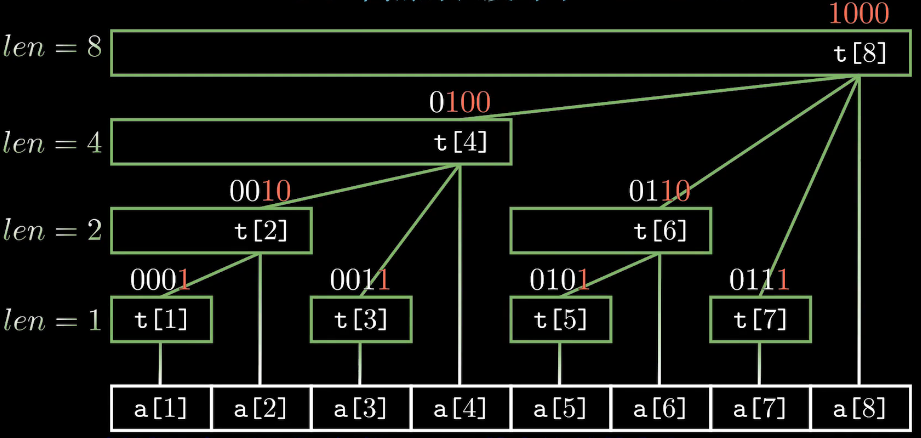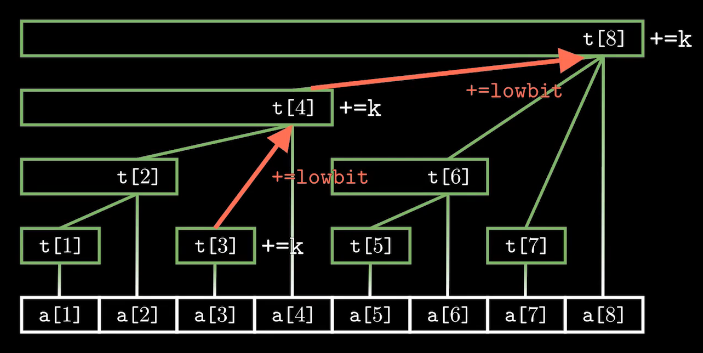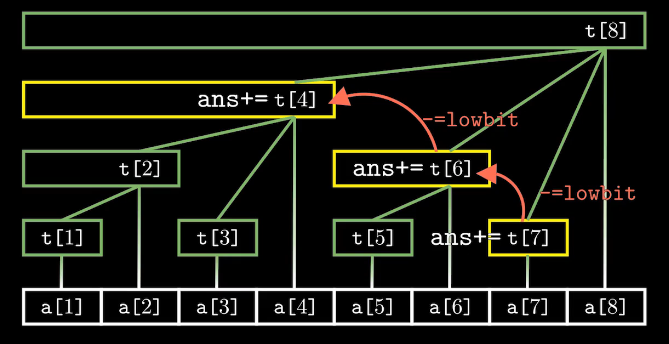lowbit()运算:非负整数x在二进制表示下最低位1及其后面的0构成的数值。
#define lowbit(x) x & -x
树状数组的本质思想是使用树结构维护”前缀和”,从而把时间复杂度降为O(logn)。

每个结点t[x]保存以x为根的子树中叶结点值的和
每个结点覆盖的长度为lowbit(x)
t[x]结点的父结点为t[x + lowbit(x)]
树的深度为log2n+1
add(x, k)表示将序列中第x个数加上k。

void add(int x, int k)
{
for(int i = x; i <= n; i += lowbit(i))
t[i] += k;
}

int ask(int x)
{
int sum = 0;
for(int i = x; i; i -= lowbit(i))
sum += t[i];
return sum;
}
修改区间和
查询元素
方法:构造tr为a的差分数组。
则修改a区间[l,r]和<=>修改tr,tr[l]+c,tr[r+1]-c
则查询a[x]元素 <=> 求tr的1~x的前缀和
#include<bits/stdc++.h>
using namespace std;
typedef long long LL;
const int N = 1e5 + 10;
int a[N];
LL tr[N];
int n,m;
#define lowbit(x) x&(-x)
void add(int x,int c)
{
for(int i=x;i<=n;i+=lowbit(i)) tr[i]+=c;
}
LL sum(int x)
{
LL res = 0;
for(int i = x;i;i-=lowbit(i)) res+=tr[i];
return res;
}
int main()
{
scanf("%d%d", &n, &m);
for(int i=1;i<=n;i++) scanf("%d",&a[i]);
for(int i=1;i<=n;i++) add(i,a[i]-a[i-1]);
while (m -- )
{
char op[2];
int l,r,d;
scanf("%s%d",op,&l);
if(op[0]==‘C‘)
{
scanf("%d%d",&r,&d);
add(l,d),add(r+1,-d);
}
else printf("%d\n",sum(l));
}
return 0;
}
修改区间和
查询区间和

因此,我们维护两个树状数组
#include<bits/stdc++.h>
using namespace std;
typedef long long LL;
const int N = 1e5 + 10;
int n,m;
int a[N];
LL tr1[N],tr2[N];
#define lowbit(x) x&(-x)
void add(LL tr[],int x,LL c)
{
for(int i=x;i<=n;i+=lowbit(i)) tr[i]+=c;
}
LL sum(LL tr[],int x)
{
LL res = 0;
for(int i = x;i;i-=lowbit(i)) res+=tr[i];
return res;
}
LL ps(int x)
{
return sum(tr1,x)*(x+1) - sum(tr2,x);
}
int main()
{
scanf("%d%d",&n,&m);
for(int i=1;i<=n;i++) scanf("%d",&a[i]);
for(int i=1;i<=n;i++)
{
LL b = a[i] - a[i-1];
add(tr1,i,b),add(tr2,i,b*i);
}
while (m -- ){
char op[2];
int l,r,d;
scanf("%s%d%d",op,&l,&r);
if(op[0]==‘C‘)
{
scanf("%d",&d);
add(tr1,l,d),add(tr1,r+1,-d);
add(tr2,l,d*l),add(tr2,r+1,(r+1)*-d);
}
else printf("%lld\n",ps(r)-ps(l-1));
}
return 0;
}
原文:https://www.cnblogs.com/aitejiu/p/15177662.html